PART IV
Baking Fires
Reflector Baking Fire (14). This fire is used for baking or roasting in a reflector oven. A high fire and some kind of structure, called a fire-back, are required to throw the heat into the oven. The fire-back illustrated is made by driving stakes and laying logs against them.
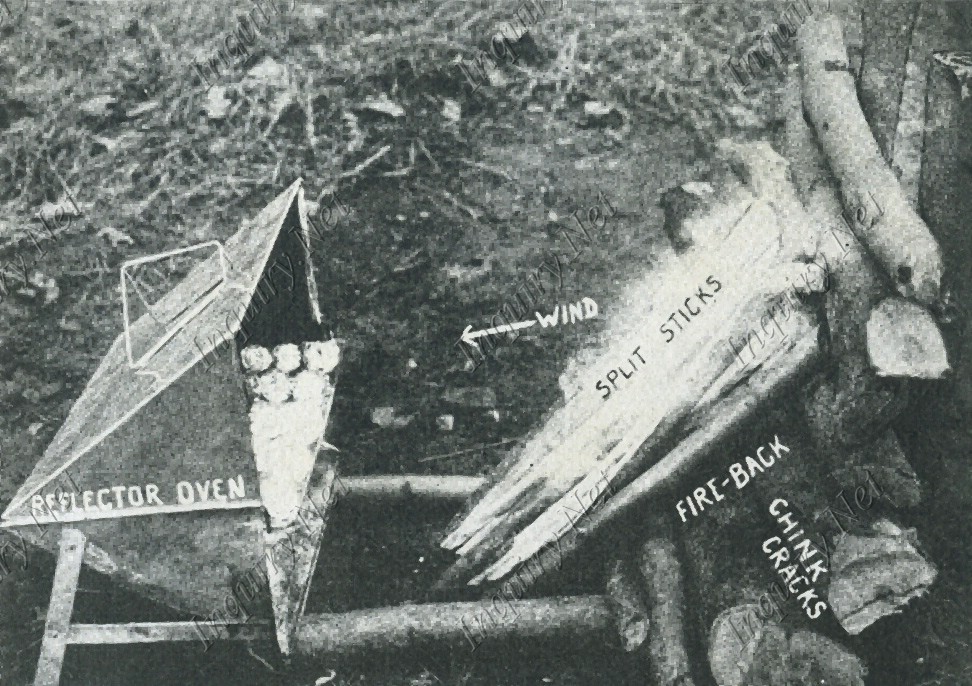
Baking with a Reflector Oven
Fast-Burning Firewoods. Since coals are not essential for this fire, common building lumber and box woods may be used. If in the woods, gather a large supply of sound dead branches about the size of your thumb. Dead laurel and old dry roots are very good for a baking fire. If green wood must be used, be sure to split it, and try to secure the better burners, such as alder, white ash, birch, dogwood, hickory, hornbeam, hard maple, white oak, spruce.
Baking Biscuit. When using a, reflector oven for baking biscuit, place it before the fire as soon as you light it, so that the biscuit will heat gradually and raise as much as possible before a hard crust is formed. When the biscuits are nearly done, place the reflector very close to the fire to brown the tops.
1. Would a large stone be as good as logs for a fire-back?
2. How should this fire be placed with reference to the wind?
3. What is the serious objection to building a fire against a decayed fallen tree?
4. How could you make a reflector oven out of a large rectangular oil can?
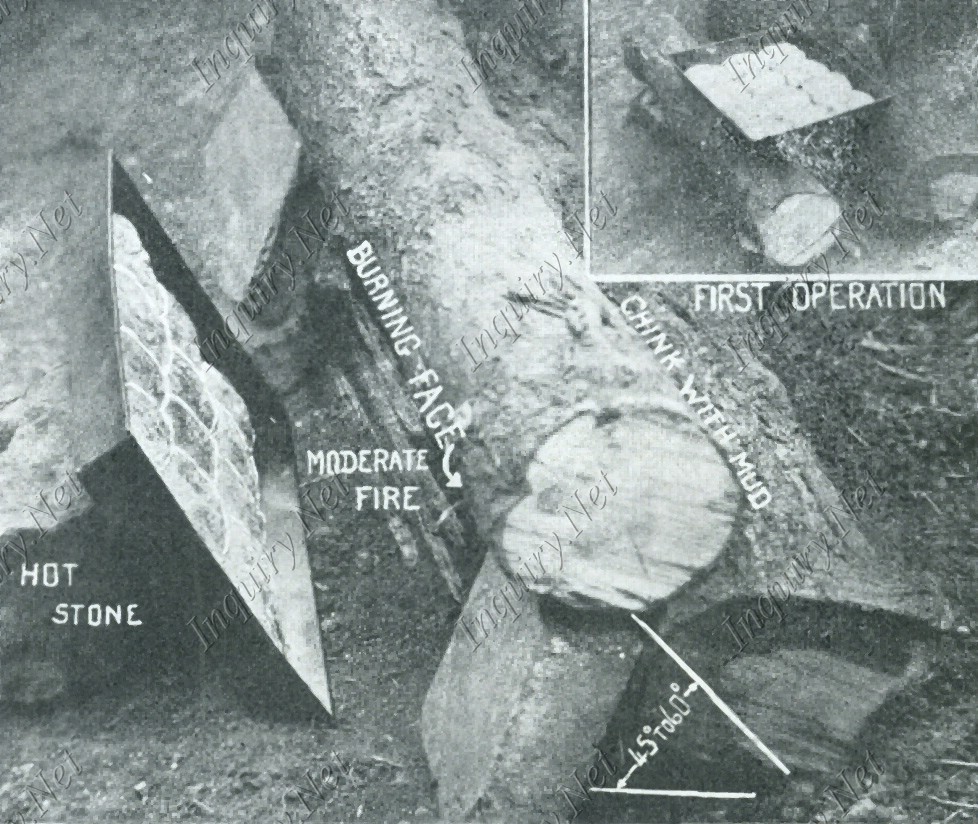
Trapper Reflector Fire
Trapper Reflector Fire (15). This ingenious modification of a trapper fire might well be included in the repertoire of every one who cooks in the open. You may be surprised to find that you can bake with it quite as well as with a reflector oven.
First build a trapper fire as illustrated in the insert, and let it burn until the side-logs are well aglow. Put the baking pan on this fire until the bottom of the meat, fish, or bread browns. (Use only moderate heat for biscuit.) Now, working very rapidly:
1st. Rotate the logs so that the glowing surfaces are in a plane of about sixty degrees; prop one log on top of the other as illustrated, or rest logs against driven stakes.
2nd. Set the pan nearly upright against a stone (preferably hot) or against a stake driven into the ground. When cooking meat, replenish the fire occasionally. No additional fuel will be required for biscuit, which will bake in ten to fifteen minutes.
3rd. Rotate the pan occasionally, and during the last few minutes place it very close to the fire for the contents to brown.
Trapper Biscuit Oven (16). This modification of the trapper fire is useful for cooking foods that will bake in moderate heat in a comparatively short time. For baking biscuit, place the pan on top of a moderate trapper fire that has burned long enough to kindle the inner faces of the logs. In about five minutes the dough will be raised and the bottom will be browned. Have everything in readiness, work rapidly, and build the trapper oven as follows :
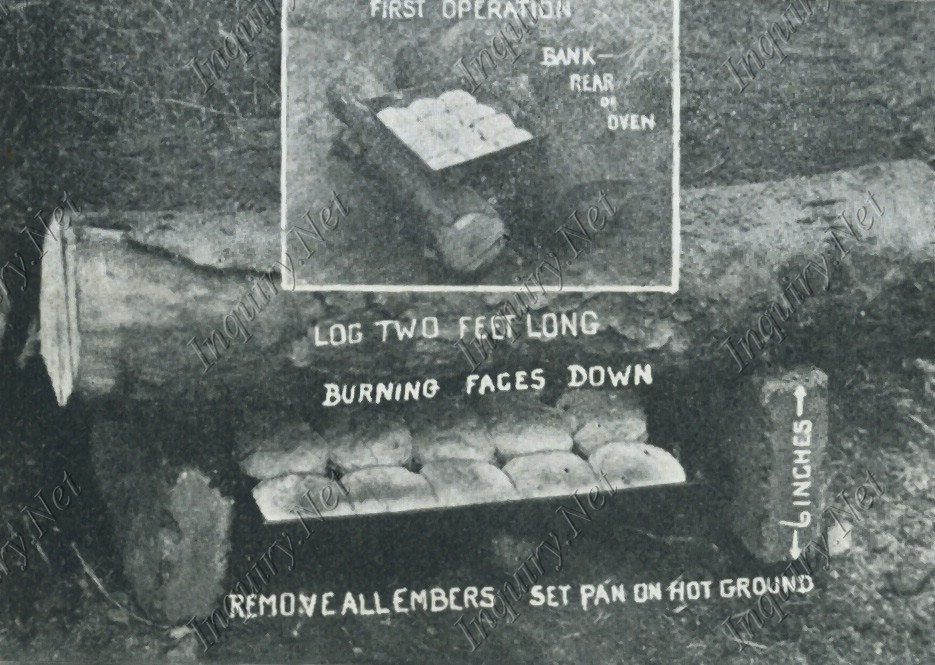
Trapper Biscuit Oven
1st. Over the spot on which the fire was burning turn the logs face downward.
2d. Place logs or stones under the burning logs to raise them from the ground and rake out the coals, thus forming the oven.
3d. Cover the pan, place it in the oven, close the front and rear, and in ten or fifteen minutes the biscuit should be baked.
1. Would you prefer to build an oven on flat ground or against the side of a bank? Why?
2. Would there be an advantage or a disadvantage in building this fireplace on a rock?
3. How would you operate this oven to bake things that require considerable time to heat?
4. What kind of logs would you prefer for the top of the oven? Could you substitute flat stones for logs?
Outdoor Stone Stove (17). This fireplace can be recommended principally for frying and baking in a permanent camp. If it is to be used for boiling, a hole should be cut in the stove top. The construction of this fireplace appeals to boy and girl campers.
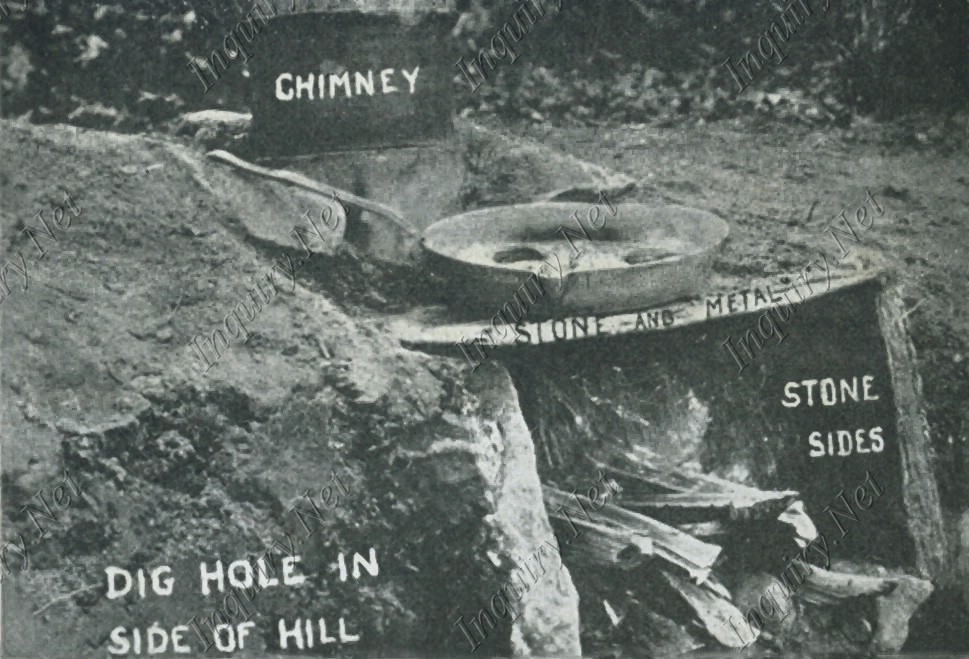
Stove for a Permanent Camp
Dig out the side of a hill, line the excavation with stones or metal, cover the top with thin flat stones or with a piece of sheet metal, and erect a chimney. Remember : the larger the stove, the more heat required and the greater the possibility of failure.
To use the stove as an oven, burn a big fire in it until the top is hot enough for frying. Then withdraw the fire, place the baking pan inside, and close both the front and the chimney. Set the pan upon something so that it does not come in direct contact with the hot bottom.
1. How would you start this fire?
2. Would a stone stove appeal to your club if built upon your regular hiking ground?
3. Would this be a good fireplace for a Scout to build in order to obtain his merit badge in cooking, or for a Camp Fire Girl to obtain a fire lore honor?
Clay Oven (18). This can be recommended principally for foods that bake quickly in a moderate heat.
Many of them are built each summer by boys and girls in camp. The tendency is to build the oven too large.
The oven is made by plastering wet clay around an inflammable form or core. Use a small empty box or barrel for the core, and leave an opening for the door. A log may be used for the chimney core. Let the clay set for a few days, carefully remove the chimney core, and complete the drying by burning a slow fire in the oven for a day. Then apply a thin coating of clay to fill up the cracks.
Prepare he oven for baking by burning an intense fire in it for an hour or two, depending upon the size of the oven. Withdraw the fire, place the food in the oven, and close both the door and the chimney.
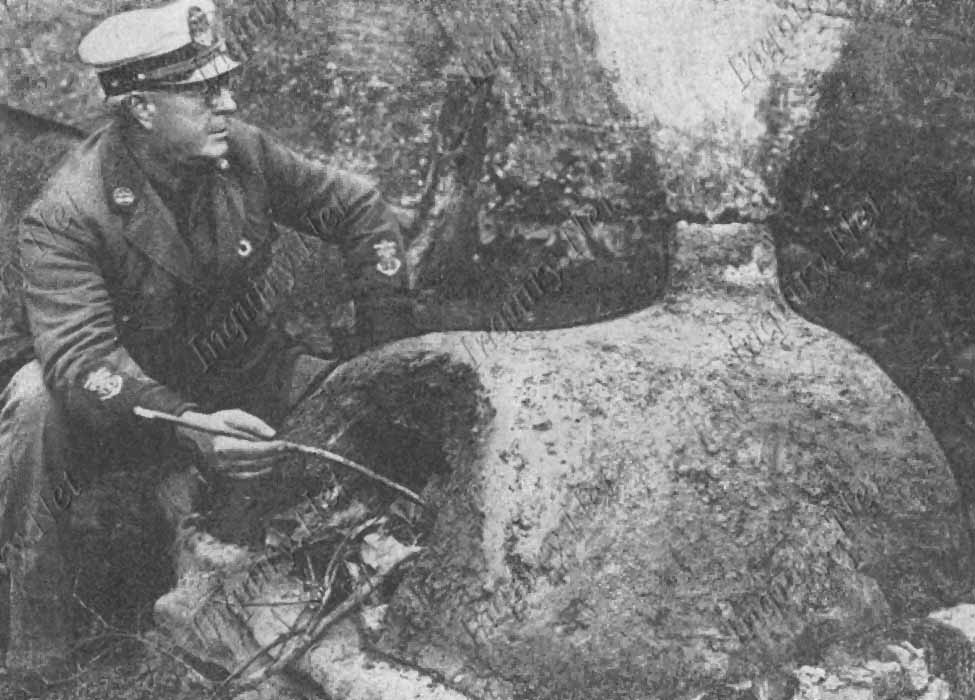
Heating the Clay Oven
1. Could a better oven be made by simply digging a hole in the side of a bank and erecting a chimney?
2.Why are ovens built upon the surface of the ground inferior to those made below the surface of the ground?
3. Would a clay oven be a good thing to recommend as a back-yard project?